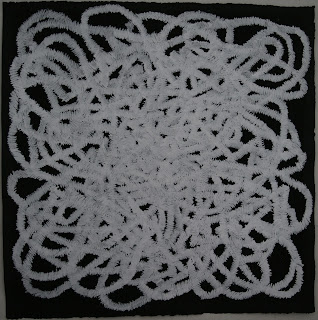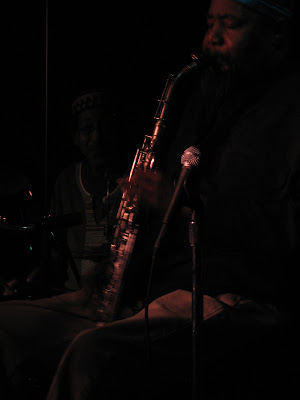 |
| Before The Storm Irene, August, 2011 copyright 2011-2 Lyn Horton |
For a long time, I have, in the back of mind, been considering writing exclusively for my blog and that time has come. It behooves me to share the reasons for withdrawing from the online publications and one print publication to which I have been contributing over a span of nearly twenty years.
The first to go was Jazzreview.com. I started writing scattered articles for Morrice Blackwell in 1996 and began to turn it on approaching the year 2000. In that year, my now ex-husband decided to go in a direction other than the one I thought I was traveling. Devastated and reeling with emptiness, urged by my son and Morrice and Joe McPhee, I immersed myself in music. I listened; I wrote. Not that how I wrote then was perfect-far from it. The performance reviews were extremely lengthy, to the point of exhaustion. The record reviews were better because I did not have much visual information to absorb and translate.
The more I attended concerts of creative improvised music, the more I learned to hear. I could detect the way instruments layered their sonic planes. The lines became clearer and clearer. The intention of my writing was and still is to describe...to filter for the reader the experience of listening and in some cases observing and becoming a witness to a series of artistic conversations whose vagaries were indeterminate, whose conclusions were complete surprises. I began to correlate my own visual creative instincts with that of musicians. The further I delved into "the music," the more of an advocate I became for this rarely instituted activity.
It was as if I was diving into a pool and learning how to negotiate the waters. Jazzreview.com gave me a consistently supportive place to practice my strokes. After about seven years or so, I changed course. Having written one concert review of the Iyer/Ladd collaboration,
In What Language, which I had seen at UMassAmherst, on AllAboutJazz.com in 2005, when the Jazzreview.com site was down for repairs, I decided to ask if I could be a regular contributor to AllAboutJazz.com. I contacted Michael Ricci, initially; he directed me to John Kelman.
My first encounter with John Kelman was off-putting; he was strident about the rules of the road at AAJ. I had to follow them to the letter. The editing of my articles was not too severe, where there seemed to have been more of a laissez-faire approach at Jazzreview.com. It was not too far in to my working with the AAJ editorial staff that one of my articles was deleted from the roster. When I asked why this was the case, the editor who deleted it emailed me with a reference to an acceptable article with the directive: "Read and learn." I thought that this instruction was arrogant and unnecessary, even though the over 500-word article I had written was horrible and I understood why it had been eliminated. I was counseled to stick with writing record reviews that were 500 words
exactly or less. The performance reviews were another matter; I could include photographs and a little more room to expand. But those articles, too, were combed and re-worded, sometimes in language I would not have used.
Nevertheless. I was learning how to write. And I was happy that I became accustomed to the bevy of limitations. Most of the time, the editing was appropriate and when I discussed what I disagreed with, a compromise was reached. I turned in over one hundred articles for AllAboutJazz.com. All of the articles gave me satisfaction; I was supported by the staff. The self-pressure to write "for the musicians" overwhelmed me. I wanted to ensure the success of the musicians rather than garner any recognition for myself. But I was happy. The musicians were happy; the record companies which sent me records for review were happy. It was a real love-fest.
With this feeling of good will amongst all involved, I took on writing for
The New York Jazz Messenger, at the time called
All About Jazz-New York, for which I was paid. The first review I wrote was negative. Despite the fact that Laurence Donohue-Greene laid the groundwork to the record company that the review of their new release was pretty dark, the article was printed. At that point, the articles in the print publication automatically were posted on the AAJ.com site. The review I had written was not posted. When I asked Laurence why, he said he did not know. He talked to Michael Ricci. A large kerfuffle ensued. It was my idea that the problem was related to advertising and money. I thought to myself, I am touching on some unattractive issues. Albeit, I was essentially naive, I was learning quickly how things go. When I saw Michael Ricci at that year's JJA Award dinner, I approached him, at which time, he apologized to me for not speaking with me directly after the incident. It bothered me that he had waited so long and that it took a face-to-face encounter to elicit a response. Everything was now smoothed over and we went on our merry way.
The development of my writing had come a long way. It was easier to write for the AAJ website than for the print publication. The latter demanded that I cut down to 250-300 words, which I eventually could do fairly easily, although I was noticing that I was not always assigned articles. I ignored that; I had enough to do. I was beginning to do profiles of musicians on the AAJ site, which I always pitched myself until Kelman suggested I do one on Wadada Leo Smith.
I did not follow Wadada’s music at the time. Cursory research on him brought me to the conclusion that I could do a profile on someone whom I did not know. The work related to Smith's profile was intense. In fact, I never worked so hard in my life. I had not known DJ Spooky or Thurston Moore or Matthew Shipp or David S. Ware when I interviewed them for profiles at Jazzreview.com. For some reason, writing those profiles did not tax me as did the mere prospect of writing about Wadada. Kelman had done me a real favor. It was my plan to check Wadada out at Firehouse 12 in New Haven in September of 2010; I was assigned the article in January that year. It took me months to research material, listen to recordings, and cull information out of two hour long phone interviews. The article was published in May.
The Smith profile became a pivotal point for me and my writing. I gained immense confidence. This marked ten years of writing. Only one musician had paid me to write liner notes. Only one publication had paid me minimally per article. And
Downbeat printed five Letters-to-the-Editor and paid me once for an article which created a bundle of controversy for the subject I covered.
I was hanging in there as I have done for so many years with my art making. I sought out yet another place where I could submit articles and perhaps be paid.
The editor at JazzTimes.com found a niche for my niche writing. He offered to pay me once for a profile on Burton Greene, but then said that the owner of the magazine was not prepared to pay for online submissions. I complied with his statement and continued to write for the online publication.
The pressure that I felt writing for JazzTimes.com was less than I felt when contributing to AllAboutJazz.com. It was my intention to submit an article on percussionist Warren Smith to AAJ; that had been determined in the fall of 2009 to be published in the spring of the following year.
I interviewed Warren in New York in January of 2010. Warren was not forthcoming with sending me recordings and other information because he was so incredibly busy performing with multiple bands. Prior to the interview, therefore, I had not been able to listen to a lot of his music; I was familiar, however, with his performances. He gave me only three or four albums when I left his apartment that winter afternoon. In the back of mind, I did not feel prepared enough to write a comprehensive profile. This is what I believed AAJ demanded of me. I emailed Kelman, the Senior Editor, and said to him that I wanted to submit my article to another publication; I did not support this action with any reasons.
It was not too long afterwards that Kelman responded, in one email saying ‘OK, see ya’ round,’ and, in the next, exclaiming that he and Michael Ricci had discussed and come to the conclusion that my submitting Warren’s profile to another publication was unacceptable: no further submissions would be accepted from me by AAJ. I was for all intents and purposes: “fired.”
In the meantime, I inquired at
The New York Jazz Messenger why I was not assigned all of the recordings which I had chosen. The editor told me that my writing was too difficult to edit so he did not bother assigning me anything; he just did not have the time to spend editing my work. I submitted my resignation to Laurence Donohue-Greene. I was tired of fighting for $10 a pop.
It was down to JazzTimes.com and me. The editor shared no grievances with me about my reviews. We worked together well. He had a zillion more tasks to tackle rather than be bothered with me. He was happy with my personal, laid-back deadlines. I gave him lists of recordings I wanted to review and he gave his approval. He was always appreciative of what I did… as were the other editors. Each of the three has told me so. So I did not feel terrible when I let them know that I could no longer submit to them except that to which I had already committed. I could not submit to them because I was not paid. There was no prospect of being paid. And if I was going to do anything with music, I would do it for my blog.
I cannot penetrate the wall built by the writers who have created the Jazz Writing Business. I have knocked on the gates as many times and in as many ways as I can.
It has been heart-wrenching, anxiety-producing, satisfying, life-affirming and often wonderful to write about music. But I am done with everything except for what I do for my blog. Here, I am the boss.
I have no regrets, I bear no resentment. It is my intention to keep on writing about subjects that matter to me: music, art and life, for heaven’s sakes. Those who know me, really know me, will understand why I am taking these steps. Even though I will be narrowing the venue for publication of my words, I will broaden my scope for writing them. Pitching to myself as I always have. The rebounds will offer new means to catch and throw again.
copyright 2012 Lyn Horton












































